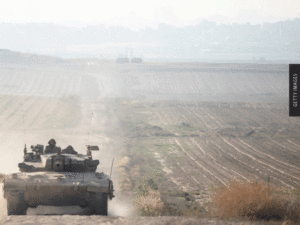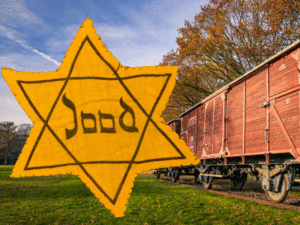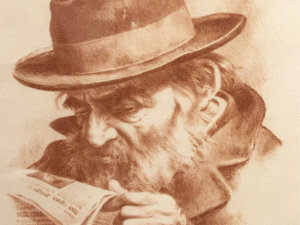We are in the camping season. A camping memory: One summer in camp, I had what’s usually called a “wild guy” for a counselor. He took us through the forest as if he knew every tree. We stopped by a babbling brook for our learning period and then we skipped from rock to rock downstream to a magnificent waterfall. He woke us up in the middle night to raid a neighboring bunk, but then sat us down to teach us about Tikkun Chatzos. I didn’t know what to make of him and I must confess that I thought he was just a bit nuts.
Then Tisha B’Av came along and everything changed. He made sure each of us had a Kinnos and knew what to say, and then sat on the floor for three hours sobbing. A river of tears formed under him, which began to seem like it would become deeper than his favorite stream. Then I knew that there was more to Heshy than met the eye. I began to notice aspects of his davening that I still try to emulate today, and I realized that we were privileged to be in the presence of an eved Hashem. I think that it was the first time I had ever seen a grown man cry, but even as an eleven-year-old, I was beginning to understand that some things in life transcend personal events. I have never forgotten those tears and they have helped me shed my own on this important day.
We know that Tisha B’Av is a day of tears. We also know that it was decreed that we cry because we cried in vain when the meraglim gave their negative report about Eretz Yisroel (Sanhedrin 104b). But how do we atone with our tears today for those unnecessary tears so long ago?
Let us listen to a description the Medrash gives us (Pesikta to Eicha Rabbosi): What was Tisha B’Av like throughout the 40 years in the desert? “Every Erev Tisha B’Av, Moshe Rabbeinu issued a proclamation that everyone should go and dig his own grave. Each person, not knowing if he would be dead or alive the next day, would bid farewell to his loved ones. We can only imagine the sobbing that ensued. Fathers and mothers, children and grandchildren didn’t know if the next 24 hours would forever change their lives for the worse.”
Indeed, every Tisha B’Av morning, when they checked the graves to see who was dead and who was alive, 15,000 Jewish souls had perished. Now the wailing was one of certainty, not of doubt. The corpses had already been interred, so no kevurah was necessary, but surely there were hespeidim. The eulogies would produce more tears and cries, all because of the cries of our ancestors, which were in vain.
Rav Dov Tzvi Karelenstein (Sefer Siach Tzedek) points out that this recurring tragic scene explains why Rav Yehudah bar Ilai (Taanis 30a-b) ruled that one must sit on Tisha B’Av lamenting over the churban as one whose loved one lies dead before him. The kapparah for the sin of our reaction to the meraglim is a serious and genuine mourning over the Bais Hamikdosh. The beginning of that process was the annual heartrending scene of 15,000 deaths in one night. Each and every Yid mourned his close relative, but also repented for the unnecessary cry about something we shouldn’t have wept about at all.
In the past year, countless of our brethren have, Rachmana litzlan, been put into the same position. In Meron on Lag Ba’omer and most recently at the site of the Champlain Towers South in Miami, people first cried because their loved ones might be gone. Then they had to cry once again when the horrific truth was discovered with the news of their sad demise. This was surely something over which to cry and mourn. Perhaps as we approach the coming of Moshiach, Hashem is, as the Chofetz Chaim often said, reconciling His books and divine calculations. Of course, we never know exactly why Hashem is making any one decision. But in the larger eschatological process, we can begin to detect patterns and purpose.
The question of the day is of course what we can do to halt this terrifying series of events.
The answer, paradoxically, is simple, yet difficult to accomplish. We were given a Tisha B’Av to cry this time for a good reason. The Gemara (Taanis 30b) teaches that one who mourns for the Bais Hamikdosh will see its rebuilding and glory. Rashi (Koheles 3:1-4) explains that when Shlomo Hamelech says that “there is a time to cry,” it means Tisha B’Av. It is not just a time to recite seemingly endless Kinnos and sit on the floor. It is a time to realize and take to heart both our loss and the great pain of Hashem Himself. The novi (Yirmiyah 31:8) exhorts us that “with weeping they will come and through supplications I will bring them.” Tears will bring both redemption and true joy.
The Medrash (Bereishis Rabbah 93:12) teaches that Yosef and Binoamin began the process even before there was ever a Bais Hamikdosh or destruction. They didn’t
cry over lost brotherly time or their personal emotions. They cried over the national loss and the pain of the Creator. Thus the Medrash concludes that “just as Yosef consoled his brothers who had sold him with his heartfelt tears, so will Hashem redeem us through our own tears.” But we must actually cry. Although it is admittedly difficult to cry over ancient events, Hashem has given us much to cry about in these past few months, and we must use these moments to shed a tear, which is more than justified and validated.
Rav Yechezkel Sarna once pointed out the seeming incongruity of celebrating the Simchas Bais Hashoeivah on Sukkos, and mourning over the Bais Hamikdosh on Tisha B’Av. Surely both evoke a time and place which is no longer, a lost greatness for which we yearn. Why do we seem to celebrate one and cry over the other?
Rav Matisyahu Salomon answers that Klal Yisroel must do two different things at various times. We must leave a blank place on our walls to remember the churban, but we must also remember the glory of the Bais Hamikdosh. Each in its own moment is crucial to our national health and – as it turns out – to our very lives. Crying over the churban can help us avoid, G-d willing, crying over contemporary tragedies. But on the other hand, recalling the grandeur of the Bais Hamikdosh can help us yearn for something none of us have ever personally seen. When we review, as Daf Yomi will shortly do, the incredible scenes of joy at Simchas Bais Hashoeivah, we will be inspired to daven and do all in our power to bring those magical moments back once again.
The Kotzker Rebbe, as always, had a sharp line about this topic. He quoted the very beginning of the Shulchan Aruch that “every G-d-fearing person should mourn and lament over the destruction of the Bais Hamikdosh” every night. The rebbe asked pointedly, “And what if one is not a yerei Shomayim?” His answer was, “Then he should mourn and lament over his own personal churban.” This is not only about a building, as grand and holy as it was. It is about us. Who are we? What are our priorities? Surely every one of us has wondered about the series of events that has befallen us, from Covid through the toppling of buildings which have buried Jews alive, Rachman litzlan. Undoubtedly, part of the antidote is the unique moed known as Tisha B’Av. Last week’s haftorah reminded us not to pursue inane and empty things that add nothing to our lives. This is a major part of mourning for the Bais Hamikdosh, which gave each of us purpose and opportunities for greatness.
Many seforim cite the fact that we have two eyes out of which to cry. Rochel Imeinu, our role model in tears (Yirmiyah 31:14), embodies this in a most elemental way. Rochel adds up to the gematriah of 238, which is twice the gematriah of dimah, which means tears. She cried for us with both eyes, meaning with all her heart and soul. We must try to do the same, on our own level, to offset the false tears that greeted the lashon hara of the meraglim.
I wish I could go back to camp and watch Heshy again on Tisha B’Av. But the truth is that we all have things to cry about that truly matter. We should all take the recent tragedies in Klal Yisroel to heart so that we actually shed tears over these precious korbanos. But perhaps most of all, we should shed tears, as the Kotzker taught us, over our own limitations and deficiencies. Tisha B’Av is a moed because it has so much potential to rectify and correct the past. Let us use this gift so that our weeping soon becomes tears of joy, be’ezras Hashem.








